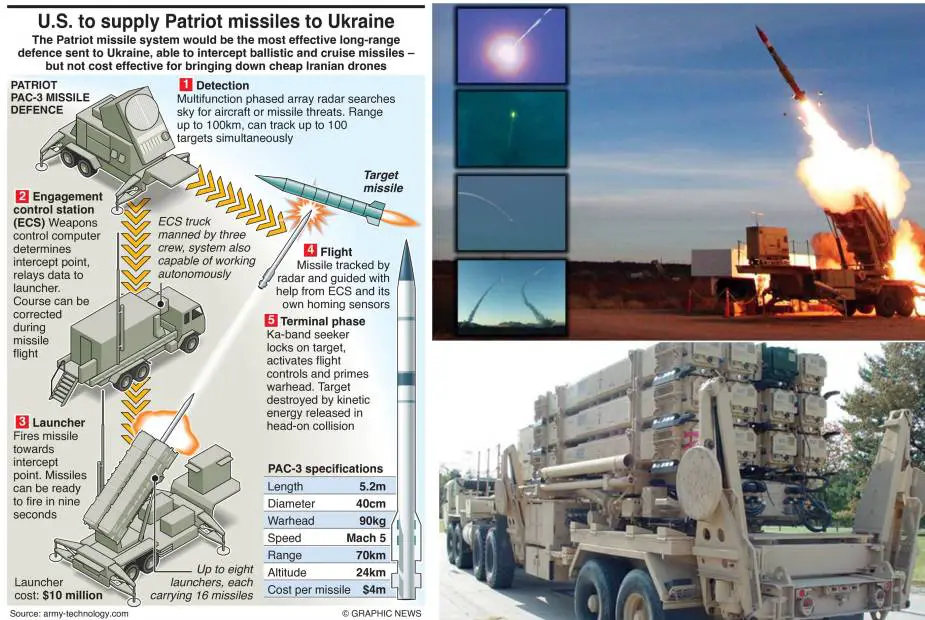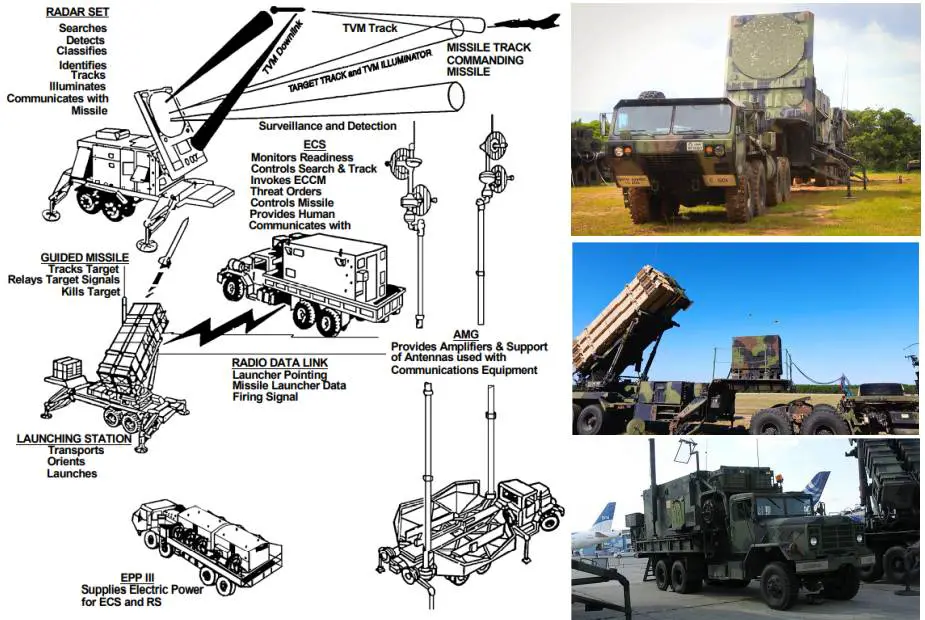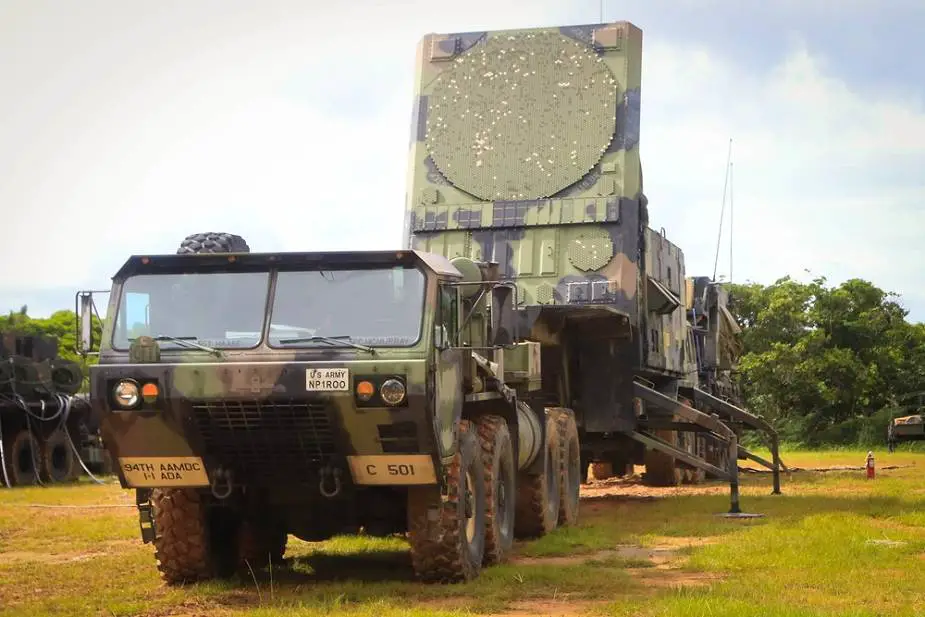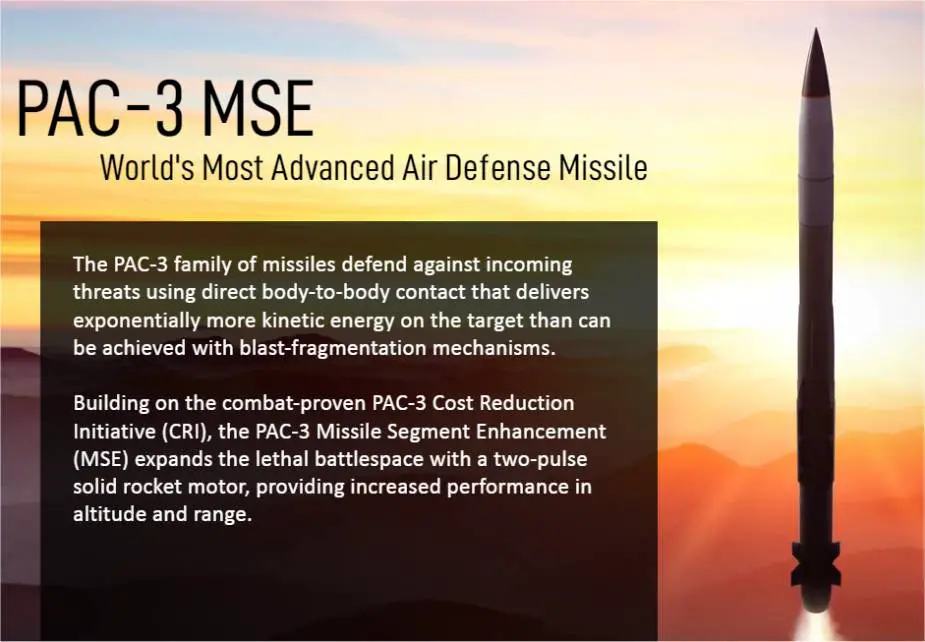Breaking news
Analysis: What is US Patriot air defense missile system for Ukraine.
On December 21, 2022, the United States confirmed the delivery of one Patriot air defense missile system to Ukraine in the framework of a new military and security assistance valued at up to $1 billion. The Patriot PAC-3 is one of the most modern air defense systems in the world and is able to intercept and destroy aerial threats such as aircraft, ballistic and cruise missiles, and drones.
Follow Army Recognition on Google News at this link

The Patriot is considered as one of the most modern air defense missile systems in the world. (Picture source Graphic News)
The main mission of the Patriot air defense missile system is to provide protection for critical assets and maneuver forces belonging to corps and echelons above corps (EAC) against airborne threats from very low to very high altitudes. The objective of Patriot operations at all levels is to disrupt and destroy the enemy's ability to mount effective air operations.
The Patriot system has four major operational functions including communications, command and control, radar surveillance, and missile guidance. These four functions combine to provide a coordinated, secure, integrated, battalion-level, mobile AD system capable of defending designated assets against TBMs (Tactical Ballistic missiles) and ABTs (Air-Breathing Targets) in an ECM (Electronic CounterMeasure) environment. The ABT is a missile with an engine requiring the intake of air for the combustion of its fuel, as in a ramjet or turbojet. To be contrasted with the rocket missile, which carries its own oxidizer and can operate beyond the atmosphere.
The main components of a Patriot battery are the fire control section and associated launchers. The major end items are the Engagement Control Station (ECS) (AN/MSQ-104), Electric Power Plant (EPP III) (M977EPP), Radar Station (RS) (AN/MPQ-53), eight Launching Stations (LS) (M901) and Antenna Mast
The Fire Direction Center (FDC) consists of Information and Coordination Central (ICC) (AN/MSQ-ll6), Electric Power Unit (EPU II) (PU 789), Communications Relay Group (CRG) (AN/MRC-137) and Antenna Mast Group (AMG) (OE-349/MRC). All these systems are mounted on truck chassis.

The main components of a Patriot battery are the fire control section and associated launchers. (Picture editing Army Recognition)
The ICC (Information and Coordination Central) is the C3 center of the Patriot battalion during AD operations. It consists of a lightweight weather-tight shelter mounted on a 5-ton cargo truck. The shelter provides shielding from radio frequency interference (RFI) and electromagnetic pulse (EMP) radiation. It is equipped with two externally mounted air conditioners that cool, heat, and ventilate the interior. An externally mounted gas particulate filter unit (GPFU) is used in NBC situations to provide clean air for crew members.
The EPU II (Electric Power Unit) is the prime power source for the ICC (Information and Coordination Central) and CRG (Communications Relay Group ). The EPU II consists of a 30 kw, 400 Hz generator mounted on a trailer and towed by the ICC or CRG. Two generators will be used for the ICC and two generators for the CRG.
The AMG (Antenna Mast Group) is a mobile antenna mast system used to carry the amplifiers and antennas associated with the UHF communications equipment located in the ECS, ICC, and CRG. Four antennas are mounted in two pairs, are remotely controlled in azimuth, and can be elevated to heights up to 30m, and 28 cm, above ground level.
The ECS (Engagement Control Station) is the operational control center of the Patriot FU (Firing Unit). It contains the WCC which is a man/machine computerized interface and various data and communications terminals. The ECS is air-conditioned and includes protection devices for use in NBC (Nuclear, Biological, and Chemical) and EMP (ElectroMagnetic Pulse) environments.

A Patriot missile radar system set assigned to the U.S. Army 1st Battalion, 1st Air Defense Artillery Regiment. (Pictures source U.S. DoD)
The RS (Radar Set) consists of a multifunction phased array radar mounted on an M-860 semi-trailer towed by an M983, heavy expanded mobility tactical truck (HEMTT). It is monitored and controlled by the ECS via the radar and weapon control interface unit. It performs very low- to very high-altitude surveillance, target detection, target classification, target identification, target tracking, missile tracking, missile guidance, and ECCM functions. The system's radar has a range of over 150 km (93 miles).
The Electric Power Plant (EPP III) is the prime power source for the ECS and RS. Each EPP consists of two 150 kw, 400 Hz diesel engines that are interconnected through the power distribution unit (PDU) and are mounted on a 10-ton M977 HEMTT. Each EPP contains two interconnected 75-gallon fuel tanks and a fuel distribution assembly with grounding equipment. Each diesel engine can operate for more than eight hours with a full fuel tank.

The PAC-3 is the latest generation of missiles in the Patriot family. (Picture source Lockheed Martin)
The Launching Station (LS) is a remotely operated, fully self-contained unit, that has integral onboard power and carries up to four guided missiles (PAC-2), or 16 missiles (PAC-3). Operation is controlled in the ECS via fiber optics or VHF data link. The LS is mounted on an M-860 semi-trailer towed by an M983 HEMTT.
The missile, from front to rear, consists of a random, guidance section, warhead section, propulsion section, and control actuator section. The Patriot missile is mounted within a canister that functions as a shipping and storage container and as a launch tube.
The Patriot Advanced Capability (PAC-3) is the latest generation of missiles in the Patriot family. The missile provides air defense against tactical ballistic missiles, advanced cruise missiles, and other air-breathing threats in the presence of electronic countermeasures and rough terrain. It has an operational range of 40 km and can intercept aerial targets at altitudes of up to 24.2 km.
Rather than relying on proximity detonation that can simply redirect or break up an incoming threat, the PAC-3 missile hits the target warhead to assure complete destruction. The PAC-3 missile achieves its hit-to-kill capability through the combination of an extremely accurate seeker coupled with an exceptionally rapid airframe response. The missile also utilizes a lethality enhancer that is designed to increase its performance against air-breathing threats. There are 16 PAC-3 missiles per Patriot launcher (versus four PAC-2 missiles per launcher) and eight launchers per Patriot battery.




























